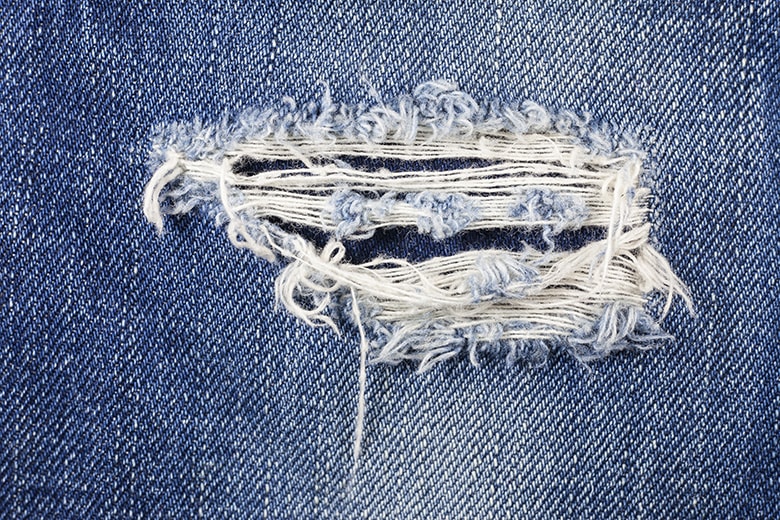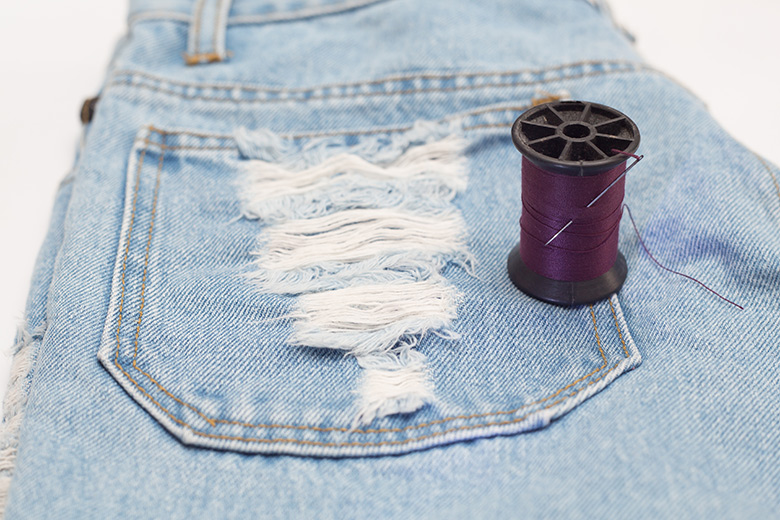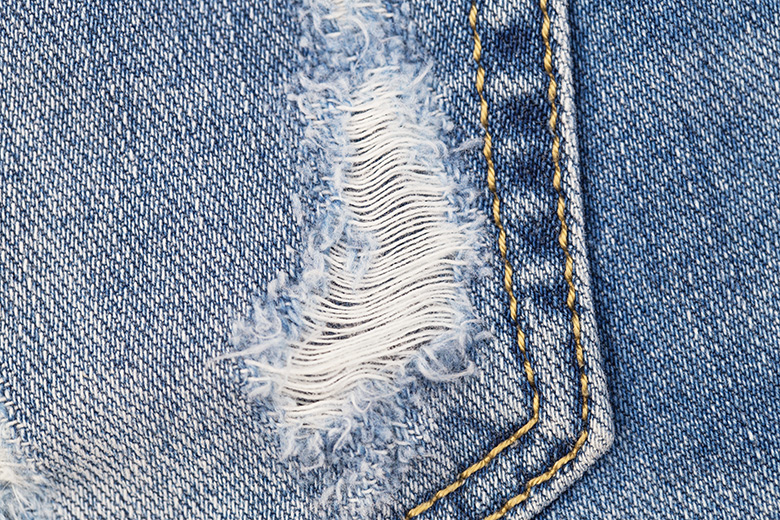You’ll look at least 40% cooler if you’re rocking a pair of torn, distressed jeans. Sure, we might be making up that statistic on the spot, but it is true that distress jeans are right in style at the moment; the more you can rip, tear, and fade those jeans, the more stylish they’re going to look.
Of course, fashion brands know this and want to charge you more for the privilege of having rips in your jeans.
With our easy step-by-step process, you can save yourself plenty of cash and create the edgy, distressed look all by yourself.
Step 1: Fade the jeans

Jeans that look like they’re made of new material that have rips and holes in them don’t look quite right, so the first step is to fade the jeans, making them look old and worn.
This can be done in two ways:
1. Painting
Get a paintbrush and a mixture of 50% bleach, 50% water.
Apply the mixture to sections of the jeans that you would like to fade. Note that jeans don’t fade uniformly over their surface area. If you want a believable faded look (you do), then get like Picasso, and be creative in where you paint on the mix. Focus on areas such as the knees where jeans naturally tend to fade the most.
Leave the painted jeans overnight before washing and drying them. (Note: To avoid a disaster, don’t combine the jeans with your other washing.)
2. Sanding
Rub sandpaper across the jeans. This will soften the material right up, age them a few years and make them comfortable as all heck, like a pair of favourite worn in jeans. Jeans can handle a lot of sandpapering, so don’t stress about possibly creating holes.
Step 2: Put the jeans on and measure where you want to distress jeans

Use chalk to mark the exact spots on the jeans that you’d like to distress. Do this while wearing the jeans to ensure there are no unwelcome surprises if you rip into the wrong area and end up showing a lot more skin than intended.
Step 3: Cut some holes into the jeans

Use a utility knife (box cutter) to cut into the jeans in horizontal strips, a couple of centimetres apart. Make the strips as long across the material as you want the hole to be.
Step 4: Remove the blue threads from the newly cut strips

Jeans will have threads of two different colours; white threads (which run horizontally across the jeans) and blue (vertical).
By removing the blue threads only, what you’ll be left with is that horizontal white threaded look that is critical to a good pair of distressed jeans. Be sure to rip just a couple of the white threads too, this way your jeans won’t look too neat to be genuinely distressed.
Step 5: Take a razor to the edges to distress jeans

A cheap, disposable razor can do so much more to a pair of jeans than it can actually shave something. Around the edges of pockets, the waistband, the zipper area or the cuffs, a razor is an invaluable tool for adding that finishing touch to the distressed look – simply “shave” the edges until they’ve got that scuffed up look.
Don’t pull out the cheese grater!
A popular alternative to the above five steps is to use a cheese grater on the jeans. This is a more efficient way of wearing the jeans down and putting holes in them, but we don’t recommend it.
The difference between distressed jeans as a fashion item and jeans that just need to be thrown away is that they are carefully designed to look the way they do. That requires careful precision in the cuts you make and the threads you pull out of the jeans. A cheese grater, meanwhile, will create a very inconsistent distressed look across the jeans. The end result is going to be a waste of a good pair of jeans.
Other ways to Distress Jeans
Distress Jeans with a Fork
You can use a fork’s prongs to scrape or fray small parts of the denim fabric to create subtle yet natural-looking wear without holes or tears. Forks are excellent when used on pockets, hems, and knees to really emphasise that natural wear effect.
When you fray denim fabric using a fork’s prong, it pulls apart the threads, leaving a textured and frayed look that doesn’t tear the jeans or leave obvious holes. Just make sure to leave the right amount of character without going overboard.
Use a File or Rasp Tool
Aside from a fork’s prongs, you can use a rasp tool or metal file to distress the jeans in target areas. Gently rub the rasp tool or file over pockets, seams, and knees, common high-wear spots, to create a soft, worn effect.
The roughness of these tools allow for more controlled distressing in areas where you want to add a subtle wear, without ruining the structural integrity of the jeans.
Create Whiskering Effects
You can also create soft whiskering effects on jeans by using a razor or sandpaper along the folds. Fold the fabric on natural creases (around hips or thighs), and gently rub the sandpaper or razor along the folded edges to slowly wear down the denim.
Mimic the natural fade lines that happens to jeans over time to add more depth and texture. If done properly, you should have a pair of jeans that look well-worn and authentic. Light and controlled strokes do the job in avoiding over-distressing.
A world of opportunity
You can easily apply similar techniques to basically anything that involves denim. This process is more time consuming than just purchasing distressed jeans. Not only will you save some cash but your jeans will be genuinely unique, and you’ll be making your own personal fashion statement.
For plenty more tips like this, or more advice on altering clothing to suit your unique sense of style, be sure to browse the LookSmart styling hub. We’re the specialists in the repair, maintenance, and customisation of clothing.
Distress Jeans with LookSmart
Distress jeans with LookSmart’s expert tailors and seamstresses. 120 stores across Australia and New Zealand. All stores provide all types clothing alterations and repairs. Most stores also provide dry cleaning, with selected stores provide styling, embroidery and dressmaking. Select your category within the store locator filter to view stores providing special services.
Frequently Asked Questions
Can I distress jeans without cutting holes?
Definitely! Distressing jeans doesn’t mean cutting holes for a fashionable look. In fact, adding textures like fraying, scraping, or sanding may even look better than seeing holes in your jeans.
You can also use forks to carefully fray the edges and seams of your jeans so they look naturally distressed with almost no tears. There’s no need to be very careful, though—it’s not surgery, after all. Just enjoy the experience, but don’t get too carried away. The key is to add texture and character while keeping the jeans intact.
What’s the best way to distress denim without damaging it?
The best way to distress your old denim jeans without ruining them is to use controlled and gentle techniques and slowly wear down the fabric. If you’re using a razor, don’t be afraid to make multiple strokes and passes with very light force rather than pushing too hard and cutting through the fabric completely.
We also recommend focusing on areas where natural wear occurs so your fraying doesn’t stand out like a sore thumb. This helps achieve a more stylish finish while preserving the piece’s durability.
Can distressed jeans be repaired if they tear too much?
If you overdo the process and damage your distressed jeans a little too much, an expert tailor can repair them. The most common method is patching the torn area from the inside using denim patches or fancy fabric patches, depending on your liking.
Another common repair is by using iron-on patches or embroidery and stitching, which both add style and flair to the piece.
At LookSmart, we also provide invisible mending techniques for seamless repairs for your most valuable pieces. It’s crucial that we find a matching thread and fabric so we can leave you with a piece with no visible damage.
Can I distress jeans without cutting holes?
Now that you’ve distressed your denim jeans, it may be necessary to soften them and complete that look with a fabric softener. If you don’t have one at home, you can also soak them in a mixture of cold water and white vinegar for about an hour.
After washing, you can tumble dry the jeans to reduce stiffness and further soften the fabric. The goal is to help make a distressed denim textured on the outside but comfortable on the inside.
How can I soften distressed denim?
Definitely! Distressing jeans doesn’t mean cutting holes for a fashionable look. In fact, adding textures like fraying, scraping, or sanding may even look better than seeing holes in your jeans.
You can also use forks to carefully fray the edges and seams of your jeans so they look naturally distressed with almost no tears. There’s no need to be very careful, though—it’s not surgery, after all. Just enjoy the experience, but don’t get too carried away. The key is to add texture and character while keeping the jeans intact.
What are the specific tools I need to distress jeans at home?
You’ll need the following tools when distressing jeans at home:
- Sandpaper and pumice stone for gentle distressing
- A craft knife or scissors for small cuts and slits
- Razor blade for roughing up edges and creating subtle frays
- Tweezers to pull out individual threads and enhance frayed sections
- Fork for small and precise fraying at natural seams and edges
- Metal file or rasp tool to rub down pockets and hems for a natural worn look
Various tools can produce unique outputs and levels of wear. Just avoid putting in too much pressure and damaging the fibres beyond fashion and repair.


